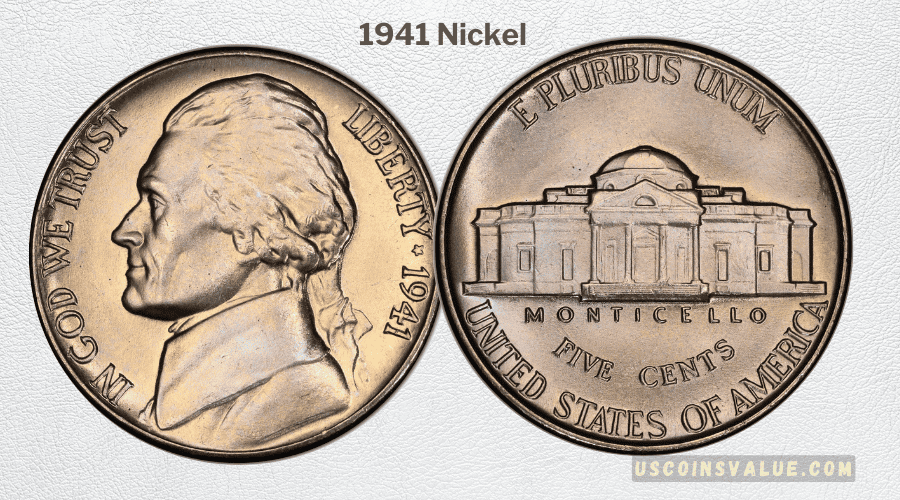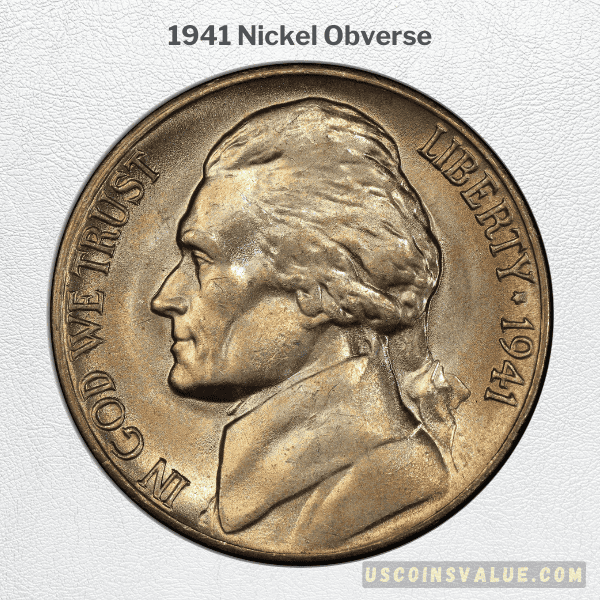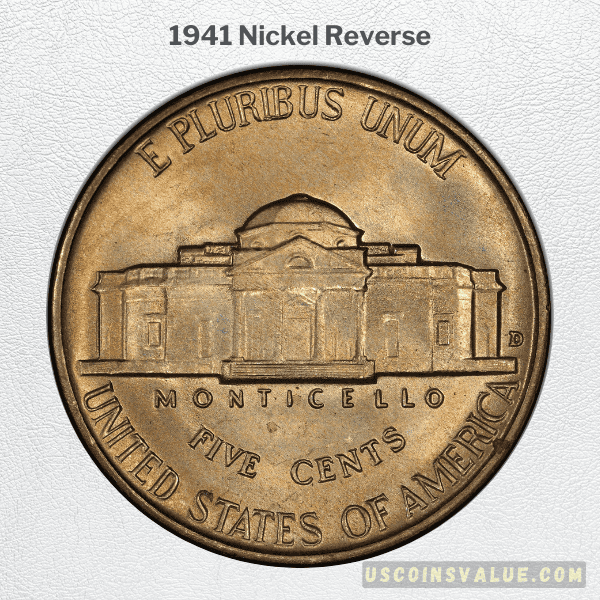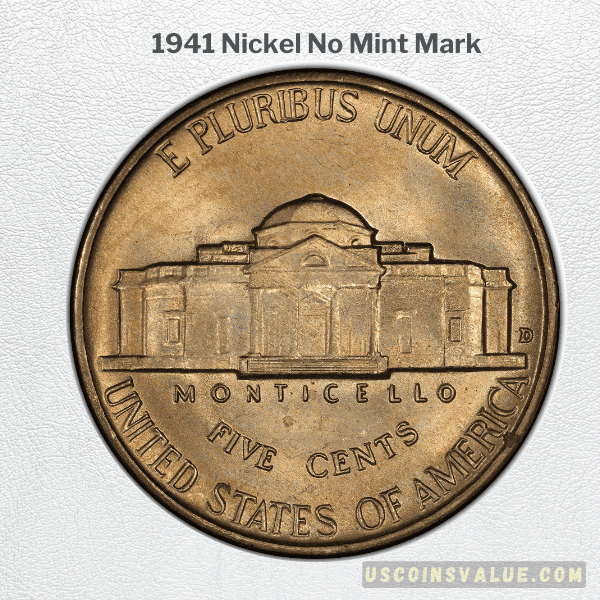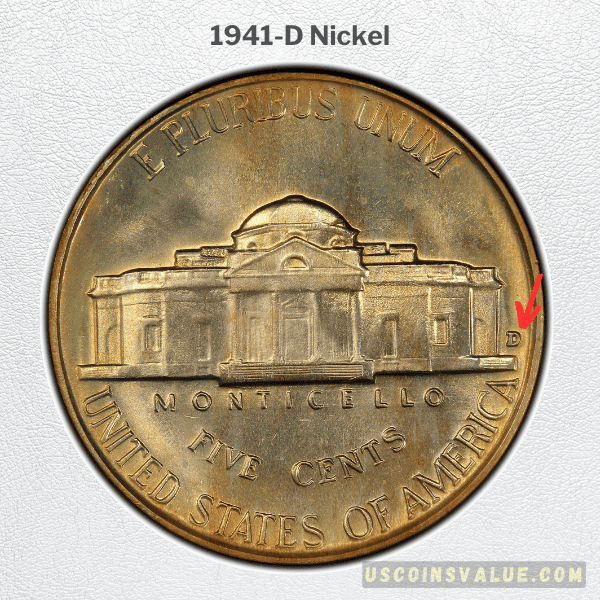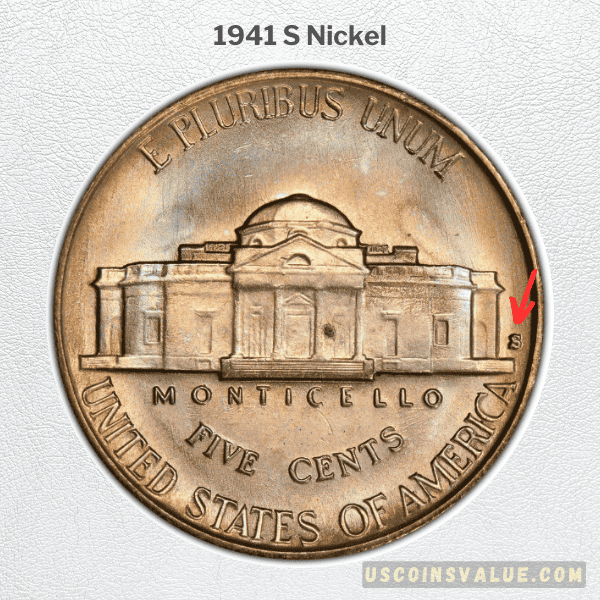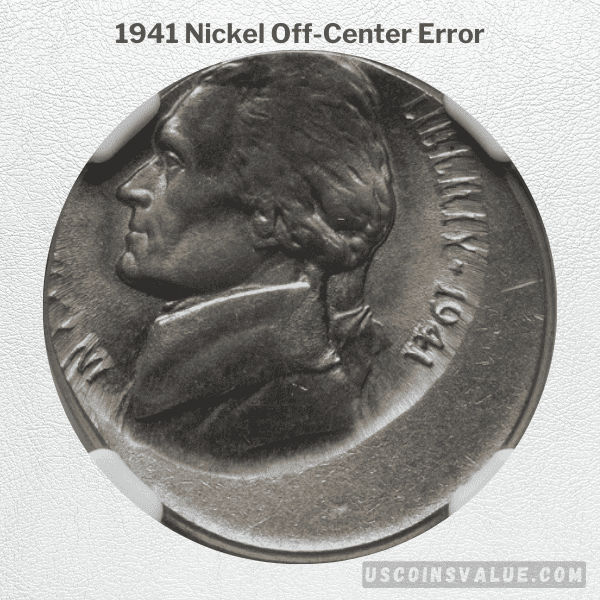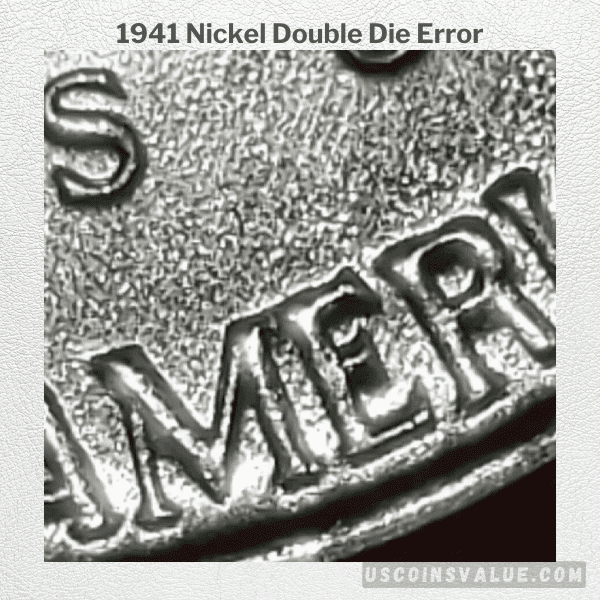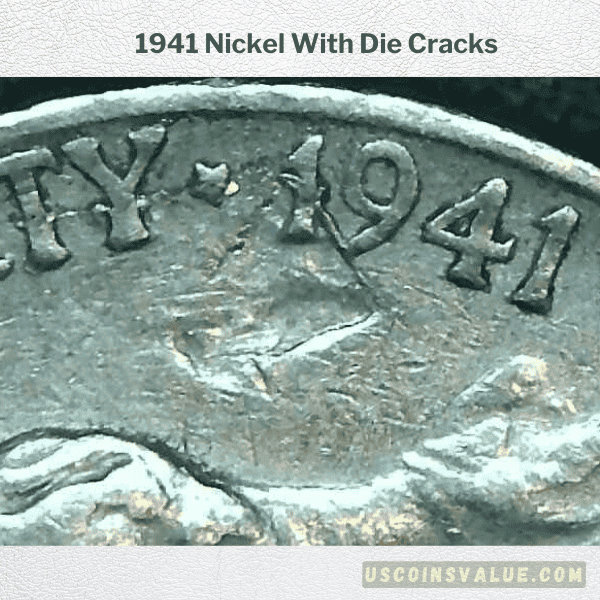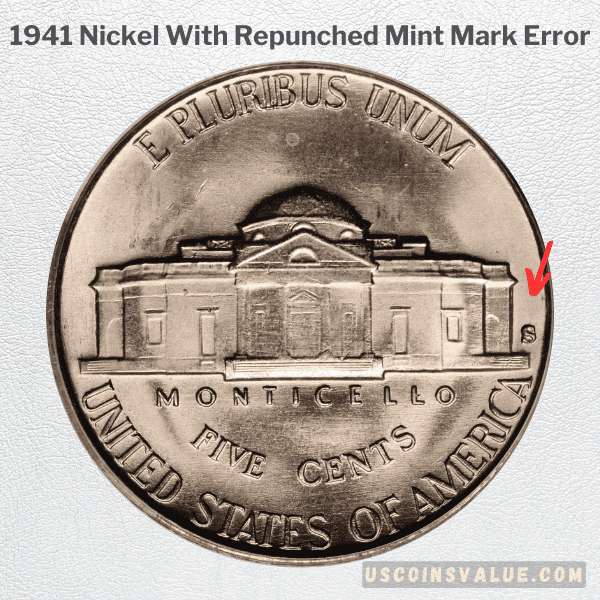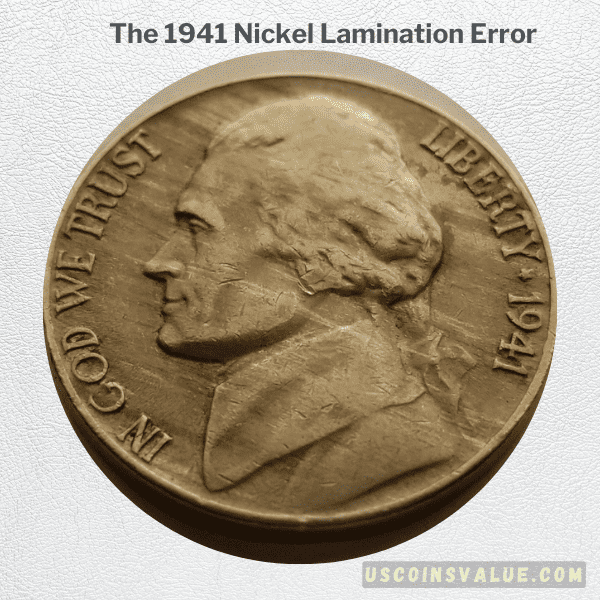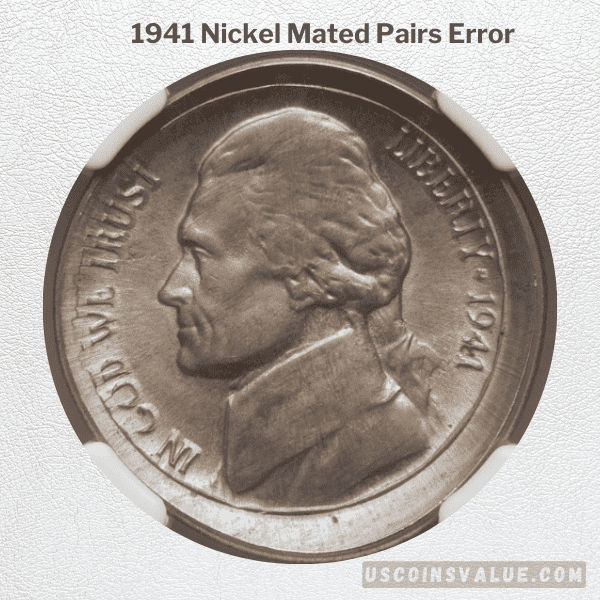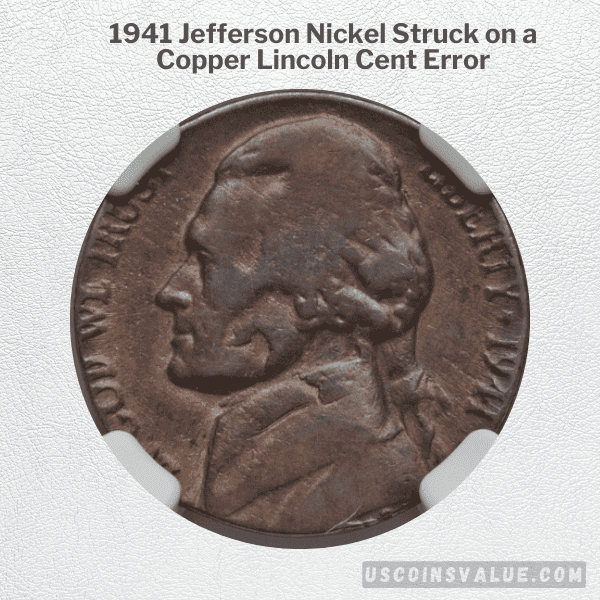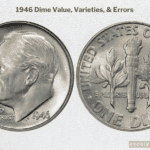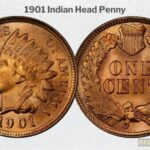The 1941 nickel is a coin of interest for collectors and history enthusiasts. Though it was designed by Felix O. Schlag in 1938, it didn’t launch until 1941 due to World War II.
Also known as the 1941 Jefferson nickel, this coin is valued at $0.17 in average condition. It can be worth $0.98 to $14 in uncirculated (MS+) mint condition. The 1941 nickel price can go as high as $11,400.
This nickel is quite distinct from other coins in the same era due to how detailed the design is. For lacking in precious material, it has a modest price tag in today’s market.
Although, the price of the nickel can change due to the grade or condition.
On the coin, you’ll find the portrait of Thomas Jefferson, the man responsible for declaring independence. Over 280 million of the 1941 nickel was minted in Philadelphia, Denver, and San Francisco.
Beyond that, other factors contribute to the coin’s worth. This article details the coin’s design, history, value, varieties, and errors, which contribute to its value.
History of The 1941 Nickel
The 1941 nickel replaced the buffalo nickels in 1938, and it lasted until 2004. It was dedicated to the third president of America, Thomas Jefferson, who was also the principal author of the Declaration of Independence.
Different American nickel coins preceded this nickel. Like other nickel coins, the 1941 nickel contained 75% copper and 25% nickel and was vital to the economy.
In 1938, the designer of the 1941 nickel, Felix Oscar Schlag, won the 1938 US mint design competition. The mint competition was meant to choose a new nickel to replace the buffalo image on the coin’s reverse.
Felix’s design included the house of Thomas Jefferson, Monticello, making him win the competition out of hundreds. Due to World War II, the coin’s production was delayed and was later introduced in 1941.
The nickel composition was changed halfway through 1942 to a blend of copper, manganese, and silver. This was to conserve metal materials for war.
Features of The 1952 Penny
| Features | Details |
| Composition | 75% copper and 25% nickel |
| Face Value | $0.05 |
| Weight | 5.00g |
| Diameter | 21.20mm |
| Thickness | 1.95mm |
| Edge | Plain |
Varieties of The 1941 Nickel
The 1941 Jefferson nickel, featuring the left-facing portrait of Thomas Jefferson, was produced in different varieties. You’re likely to come across any or all of these varieties:
- 1941 Nickel No Mint Mark (minted in Philadelphia)
- 1941-D Nickel (minted in Denver)
- 1941-S Nickel (minted in San Francisco)
Each variety is different, with varying factors contributing to their features and values.
Mintage in each of the facilities is as follows:
- Philadelphia Mint = 203,265,000
- Denver Mint = 53,432,000
- San Francisco Mint =43,445,000
Obverse And Reverse Design
The obverse side of the 1941 nickel has the left-facing portrait of America’s third president. Then Felix, the 1941 nickel designer, further wrote the following inscriptions on the same side:
- IN GOD WE TRUST – the motto on the left side of the coin
- LIBERTY * 1941 – on the right side, behind Thomas Jefferson
The coin’s reverse is a bit more complicated as it has more characters than the obverse. The historic home of Thomas Jefferson is centrally positioned on the coin’s reverse, with the name MONTICELLO, written right below it.
Then, some inscriptions are also placed around it, like:
- E PLURIBUS UNUM – curved above the house, meaning “out of many, one.”
- D, S, or NO MINT MARK – written between the Monticello building and the right rim of the coins.
- FIVE CENT – curved under the name of the house
- UNITED STATES OF AMERICA – boldly curved below the FIVE CENT
Note
The “No Mint Mark” (Philadelphia Mint) has no inscription between the building and the coin’s rim. On the other hand, the “D” and “S” inscriptions signal the Denver and San Francisco mint marks, respectively.
1941 Nickel Value
The value of the 1941 nickel varies depending on the mint mark. Generally, 1941 nickels with mint marks “d” and “s” are slightly more expensive than the ones without the mark with a few cents.
In addition, the rarity and preservation level of the coin also contribute to its worth. Typically, the three varieties of the 1941 Jefferson nickel are valued at a face value of five cents and up to $15 for well-preserved coins.
Only coins with grades 67 and above usually fetch substantial amounts and must be in impeccable condition. The highest amount paid for a 1941 nickel is $11,400 when a collector paid for an almost flawless D-minted nickel.
The nickel was rated at grade 68.
| Mint Mark | Uncirculated | Extremely Fine | Fine | Good |
| 1941-S Nickel Value | $15 | $0.58 | $0.25 | $0.15 |
| 1941-D Nickel Value | $13 | $0.47 | $0.25 | $0.15 |
| 1941 Philadelphia Nickel Value | $15 | $0.35 | $0.25 | $0.15 |
1. 1941 Nickel No Mint Mark Value
The 1941 nickel with no mint mark was produced at the Philadelphia Mint. It is distinct from its minted counterparts and was mainly for circulation purposes.
The US Mint purposely produced this coin without the mint mark to conserve metal during the war. This was also to preserve nickel at the time because it was important for making armory.
On average, this nickel value can range from $0.15 to $15 and can be worth thousands of dollars if it’s in excellent condition. As you know, the nickel value depends on the grade and the state of the coin.
You can gauge the value of the 1941 nickel with recent coin auction prices.
| DATE | PRICE ($) | GRADE | SVC |
| JAN 2023 | 71 | MS66FS | PCGS |
| FEB 2023 | 90 | MS66FS | PCGS |
| MAY 2023 | 159 | MS67FS | NGC |
| MAY 2023 | 252 | MS67FS | PCGS |
2. 1941-D Nickel Value
This is one of the minted 1941 nickel, and it is produced in the Denver mint. The “d” mint mark can be seen on the coin’s reverse between the mansion and the coin’s edge.
These coins account for more than one-fifth of the 1941 Jefferson nickel produced. Like most coins, the 1941-D nickel value depends on the state of the coin. Typically, it can sell for between $0.3 and $12.
However, it can be valued at thousands of dollars if it is in excellent condition. As of 2018, a 1941-D nickel was sold for $11,400 at an auction.
The most recent value of the 1941-D nickel varies, which you can confirm or see below:
| DATE | PRICE ($) | GRADE | SVC |
| JAN 2023 | 22 | MS65 | PCGS |
| FEB 2023 | 124 | MS67FS | NGC |
| JUL 2023 | 3,000 | MS68FS | NGC |
| Jul 2023 | 3,120 | MS68FS | NGC |
| JUL 2023 | 3,001 | MS68FS | NGC |
3. 1941-S Nickel Value
The 1941-S nickel was minted in the San Francisco Mint. It is one of the least produced 1941 nickels and only accounts for less than one-sixth of the production.
As a result, scarcity contributes to its value. Beyond this, the condition and grade of the coin also determine its worth.
Generally, the coin can be worth hundreds of dollars depending on its mint condition. More so, it can be valued up to thousands of dollars if in excellent condition.
For example, the 1941-S nickel was sold at an auction for nearly $8,913 years ago. At more recent auctions, the 1941-S nickel value has dropped below that.
| DATE | PRICE ($) | GRADE | SVC |
| NOV 2022 | 17 | MS64 | PCGS |
| DEC 2023 | 124 | MS64 | PCGS |
| MAY 2023 | 288 | MS66 | PCGS |
| MAY 2023 | 336 | MS67 | PCGS |
1941 Nickel Error list
1. 1941 Nickel Off-Center Error
One of the 1941 nickel errors was the off-center error, which affected the coin’s design. This means that the design wasn’t appropriately struck in the center of the planchet, whether on the obverse or reverse side.
Depending on the degree of the off-centering, the value can go higher. That is, the 1941 nickels with more significant off-center errors, more valuable it’ll be for collectors.
It costs up to $270 on eBay or $410 on auction platforms. Also, prices can increase if the off-center design has a visible date.
2. 1941 Nickel Double Die Error
Double die error is one of the most common coin errors. You can tell the double die error on a 1941 nickel if the design appears to have been struck twice, creating a doubling effect.
This error is unusual and can raise a coin’s value depending on its quality. Double die error on a 1941 nickel can significantly increase its value, making it worth up to hundreds and even thousands of dollars.
3. 1941 Nickel With Die Cracks
Die crack errors can occur in coins and manifest as missing or distorted designs on coins. As a result, these die cracks give the 1941 nickels distinct looks.
This error can appear on the obverse or reverse side of the coin and vary in size and shape. Unlike other coin errors that increase a coin’s value, die crack errors can lower the value of a coin.
Therefore, collectors may regard the 1941 Jefferson nickel with die cracks as a minor variant compared to one without it. This can make it cost about $25 selling price on online markets.
4. 1941 Nickel With Repunched Mint Mark Error
Repunched mint mark error occurs when the mint mark is struck on the nickel more than once, leaving a double, tripped, or quadrupled imprint on it. This error is often more pronounced in the “D” mint mark.
The error and condition of your 1941 nickel contribute to its value. 1941 nickels with this error can cost about $20.
5. The 1941 Nickel Lamination Error
Lamination error in coins isn’t that common. It occurs when an alloy of copper and nickel used in production gets contaminated.
This, in turn, affects the coin’s integrity, separating its layers. The severity of the lamination error in the 1941 nickel can cause cracks and thin flaps on the obverse or reverse surface.
Lastly, this error can increase the value of your 1941 nickel by a few dollars. You can get it for about $28 on an online store.
6. 1941 Nickel Mated Pairs Error
Mated pairs error occurs in coins when two or more coins are struck at the same time or at successive strikes. This results in errors that often fit together as a set.
Sometimes, the mated pairs can be discovered together, but it’s rare. Some 1941 nickels with different errors and struck together also result in mated pairs error.
Also, they can be overlapped where one of the pairs is struck off in the center on top of the other coin. A 1941 Jefferson nickel with mated pairs error can cost about $14.
7. 1941 Jefferson Nickel Struck on a Copper Lincoln Cent Error
Another 1941 nickel you may come across is the 1942 Jefferson nickel struck on a copper Lincoln cent. For this error, the 1941 Jefferson and copper Lincoln overlap.
You may notice parts of the right wheat ear on the copper Lincoln close to “E PLURIBUS UNUM.” A 1941 nickel with this error can cost a minimum of $14 per lot.
Conclusion
The 1941 nickels hold a place in history, especially since their production material was changed to preserve the armory during the war. However, their story extends beyond that time, as collectors see value in them by adding it to their collections.
Now, they are valuable coins valued up to hundreds and thousands of dollars. To get value for your 1941 Jefferson nickel, it must be in excellent condition, ranging between fine and unmounted grade.
In addition, coin value increases based on its grade and unique errors that it has. Therefore, you should consider appraising your 1941 nickel before selling it to get the worth of your valuable coin.

